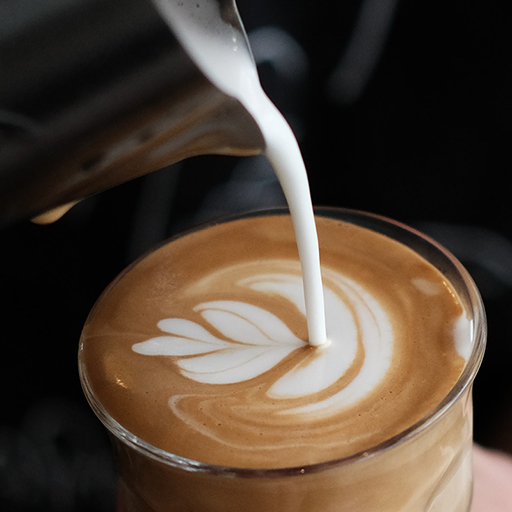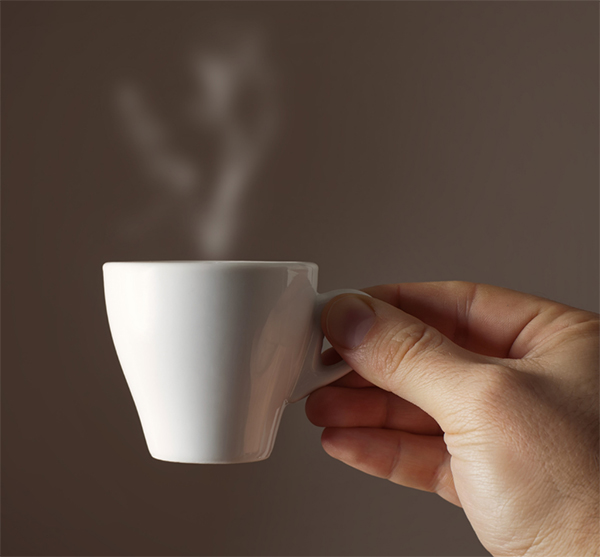So you’ve had your share of cappuccinos and flat whites, but you’re still uncertain about their differences. Not to worry, I got you covered! In this article, I will be going over the Flat White Vs Cappuccino by taking a look at their history and diving into their similarities and key differences to help you determine which type of coffee would be best for your taste.
The main distinction between a flat white and a cappuccino is the preparation of the milk. A cappuccino consists of espresso with steamed milk and milk froth (macrofoam). The flat white consists of espresso with a micro-foamed layer of milk with no froth.
What is Microfoam (Wet Foam)?

Microfoam is milk that has been steamed to a finely textured consistency that is smooth, silky and very meringue-like with tiny air bubbles.
What is Macrofoam (Dry Foam)?

Macrofoam is milk that has been steamed to a textured consistency that is airier, thicker, and has larger air bubbles than the Microfoam milk.
What is a Flat White?

The flat white is an espresso-based milk coffee that contains 1-2 shots of espresso and it is topped with microfoam milk without any dry froth. The drink gets its name from its signature top thin layer of microfoam.
The story has it that the inventor of the Flat White wasn’t particularly keen on the Cappuccino, for it was loaded with too much froth and came off as a “girly” coffee. So the idea of a Cappuccino with a haircut came about. Now, considering it’s the ’80s, so what better haircut to give the coffee than a flat top cut, right? HA! The Flat Top Cappuccino was born! This snazzy new coffee was missing one thing, it needed a proper name. Since traditional coffee with milk was already known as “white coffee” it became a “Flat White”. Though it would be funny if this “urban legend” was true, for a more accurate story, continue reading.
Typically one single serving of the classic flat white consists of the following measured ingredients:
- 1 or 2 Ounces of Espresso (A Ristretto works great)
- 4.4 Ounces of Micro-foam/Steamed milk
The coffee is served in a ceramic, 5 ½ oz tulip-shaped cup with a saucer.
Brief History of Flat White:
The Flat White originated around the 1980s from either Australia or New Zealand. Some believe that it was first created in Wellington, New Zealand. Australians say that Flat White is 100% Australian, while New Zealand believes it is a Kiwi invention; neither country is willing to settle on this matter.
New Zealand claims Derek Townsend invented the drink in 1984. While other rumours point to a barista named Fraser McInnes who invented the drink in 1989. Fraser’s business partner listed it as “A Wellington Flat White – A Failed Cappuccino” on their cafe’s blackboard. (1)
Soon enough the Flat white exploded and caught the eye of Starbucks. It was introduced to their menu in 2010 for their European cafes and entered the U.S. in 2015.
How to Make a Flat White?
- 1: Begin by pulling 1-2 shots of espresso into your coffee cup. Many baristas resort to a Ristretto as a base for the Flat White. A Ristretto is a concerted type of espresso shot that uses half the water of a normal espresso shot.
- 2: Add your milk to the frothing jug and begin steaming.
- 3: Steam your milk to about 60 degrees Celsius.
- 4: Stop steaming when you notice that your milk has a fine and silky consistency and nearly no froth.
- 5: Pour your microfoam milk into the centre of the cup and over the espresso.
- 6: Enjoy your flat white.
P R O T I P
To achieve a successful pour, its important that you start up high with the milk stream and slowly come down with the stream until you fill the cup.
What is a Cappuccino?

Cappuccino is an Italian term that refers to a “hood”, which is pronounced ka-pu-chee-now. Think of the milk froth being a hood for your espresso and milk. The term is inspired by the religious habits of the Capuchin friars. The habits were of similar colour and contained a hood.
The cappuccino can be served in a few different ways. Aside from the traditional cappuccino, there’s a dry cappuccino, bone dry cappuccino, a wet cappuccino and super wet cappuccino.
What is a Dry Cappuccino?

A dry cappuccino is made up of an espresso base (1-2 oz) and has more milk froth and less steamed milk. There’s a lot more air in this coffee due to the increase in foam, hence the name “Dry”. Some speculate that due to the increase in milk foam and a decrease in milk the coffee stays warm longer. A dry cappuccino will also be a bit stronger in taste than a traditional one. Since there is less milk to blend with the espresso.
What is a Bone Dry Cappuccino?

A bone dry cappuccino is made up of the standard espresso base (1-2 oz of espresso) and milk froth (foamed milk). The steamed milk is subtracted.
What is a Wet Cappuccino?

A wet cappuccino is made up of the standard espresso base (1-2 oz of espresso) and more steamed milk and less milk froth.
Wait… Isn’t this a Latte? Not exactly, though it can get quite confusing. A Latte has far less milk froth (foamed milk) than a wet cappuccino. If you’d order a super wet cappuccino, then you’d probably get something similar a a Latte.
What is a Super Wet Cappuccino?

A super wet cappuccino is made up of the standard espresso base (1-2 oz of Espresso) and steamed milk and no milk froth, some baristas will apply a dash of froth just to keep this coffee in the cappuccino territory.
However, in a coffee house, one small cup of traditional cappuccino consists of:
- 1- 2 Ounces of Espresso
- 2 Ounces of Steamed Milk
- 2 Ounces of Foamed Milk (Milk Froth)
A traditional cappuccino is usually served in a round 6oz ceramic cup with a saucer.
Brief History of The Cappuccino

The cappuccino goes back a long way, long before the espresso machine.
It all started sometime in the 18th century when the Viennese gave birth to the “Kapuziner”, which was a coffee with whipped cream and spices. The name stemmed from the light-brown colour habits of the Capuchin monks. The Kapuziner thrived in Viennese-style cafes in Trieste, eventually making its way to northern Italy in 1930’s where it was served similarly and named “Cappuccino”.
It wasn’t until decades into the 20th century when the use of commercial espresso machines began to arise in cafes around Italy when the preparation method of the coffee drink took a turn. The cappuccino developed into a coffee made with espresso and frothed milk, garnished with some cinnamon or chocolate. Yup, it became slightly different.
How to Make a Cappuccino?
- 1: Begin by pulling 1-2 shots of espresso into your coffee cup.
- 2: Fill the frothing jug with the milk and begin to froth.
- 3: Keep an eye on the milk during the frothing process, and continue to froth until the milk becomes thick and foamy. Just under 70 degrees Celsius is the approximate temperature for your froth.
- 4: Now pour the steamed milk slowly over the shot(s) of espresso while retaining the foam back, some use a spoon, others can feel it out.
- 5: Complete the cappuccino by adding approximately one centimetre of the foamy milk on top of the steamed milk.
- 6: Garnish with some powdered chocolate or cinnamon. Enjoy!
Flat White Vs Cappuccino – The Similarities and their Differences
Flat White Vs Cappuccino Similarities
● The flat white and cappuccino are both espresso-based coffees and can range from using 1 to 2 shots of espresso. Both are milk-based coffees though the milk can be substituted for any other variety of milk like soy, oat, almond, etc.
Flat White Vs Cappuccino Differences
● The most fundamental difference is the form of the milk; the two drinks also have different origins.
● The texture and volumes between the drinks vary. A flat white is generally a lot smoother than the cappuccino with the milk having a velvet-like consistency and silky finish with no froth. A cappuccino is much denser with a head of froth that almost overflows the surface of the cup, leaving you with an extremely rich and foamy finish. A cappuccino is traditionally served in a 6oz ceramic cup. A flat white is served in a 5.5oz ceramic cup. Sometimes baristas will serve these drinks in glassware to show off their multilayer structure.
● The flat white and cappuccino are composed primarily of steamed milk and espresso, but the method for steaming and pouring the milk, and the cups in which the drinks are served in, greatly differentiate these drinks.
● The flat white is also a lot stronger in taste than the cappuccino. If you’re one that likes a bit of a punch or likes to taste the espresso, then a flat white would be your ideal choice.
● When it comes to nutritional value, the flat white would pack more calories since it has slightly more milk than the cappuccino. Both of these coffees can be made calorie friendly with the use of low-fat milk and other milk substitutes.
The Flat White Vs Cappuccino Conclusion
Milk preparation and proportions are the main differences between these coffee drinks. The right texture and foam formation ensures the appropriate taste in the mouth, but also how it combines with the coffee and produces your drink’s unique flavour. You need the steaming function of an espresso machine or a milk frother to make velvety foamed (microfoam), frothed (macrofoam), or steamed milk. If you keep in mind the right proportions for your cappuccino and flat white, you’ll create the perfect coffee drink. Good luck, and enjoy!
IF YOU’VE ENJOYED THIS ARTICLE, GIVE IT A PIN!



























3 comments